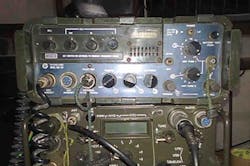Software-Defined Radios Accelerate Wireless-System Design Cycle
This file type includes high resolution graphics and schematics when applicable.
Mobile data traffic is at an all-time high and rising. Current figures, for example, put today’s traffic at 50 times that of 2009. The wireless industry is responding by adding capacity with the incorporation of heterogeneous networks, relays, and enhanced algorithms. Although wireless-communications researchers have a wealth of options to explore, they are challenged by the implementation and testing of these different methods. In a four-page white paper titled, “Prototyping Next Generation Wireless Systems with Software Defined Radios,” authors from National Instruments discuss methods for rapidly prototyping wireless systems using these recently enhanced devices.
Software-defined radios (SDRs) combine traditional radio hardware with programmability. They also actively include advanced computer interfacing for highly customizable test solutions. As a result, researchers could prototype and test their new systems’ performance and generate iterative design improvements more rapidly. Additionally, SDRs could be implemented in test systems in real-world applications, enhancing the effectiveness of wireless testing. Yet these potential benefits come at a cost of increased complexity and the need for high-performance computational systems.
A potential solution for researchers is the SDR comprised of general-purpose processors (GPPs) and field-programmable gate arrays (FPGAs). The multicore operation of modern GPPs allows for increased processing performance. Additionally, high-speed FPGAs could be tasked with the real-time signal processing of the radio systems for a combined SDR enhancement. An additional enhancement would be ease of use and accuracy when developing software for the SDR system. This aspect would compensate for the increased complexity of adding GPPs and FPGAs to the SDR.
Of course, there could be risks to abstracting the design from a hardware base, like sacrificing the optimization of resources for prototyping speed. With a software development environment that allows for multiple layers of abstraction, some systems could be abstracted and simplified for rapid prototyping while more critical systems could be attended to with less abstraction. A software tool that could also efficiently handle the multicore, parallel execution, pipelined architecture, and multiple data flow paths could pair well with parallel-execution SDR systems. As an example, the paper points out how NI’s LabVIEW graphic design system can be closely integrated with the Universal Software Radio Peripheral (USRP) SDR system.
National Instruments, 11500 N. Mopac Expwy., Austin, TX 78759; (512) 683-0100.
This file type includes high resolution graphics and schematics when applicable.
About the Author
Jean-Jacques DeLisle
Jean-Jacques graduated from the Rochester Institute of Technology, where he completed his Master of Science in Electrical Engineering. In his studies, Jean-Jacques focused on Control Systems Design, Mixed-Signal IC Design, and RF Design. His research focus was in smart-sensor platform design for RF connector applications for the telecommunications industry. During his research, Jean-Jacques developed a passion for the field of RF/microwaves and expanded his knowledge by doing R&D for the telecommunications industry.

